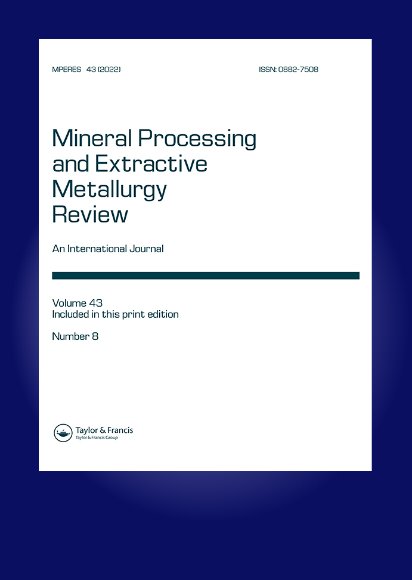Iron Ore Pelletization: Part III. Organic Binders
IF 4.6
3区 工程技术
Q1 METALLURGY & METALLURGICAL ENGINEERING
Mineral Processing and Extractive Metallurgy Review
Pub Date : 2023-02-17
DOI:10.1080/08827508.2022.2029431
引用次数: 6
Abstract
ABSTRACT This part reviews the goals of introducing organic binders into iron ore pelletization. Organic binders present a relatively small number of unique binding options but provide an extraordinary amount of flexibility in how to apply them. The key factors that lead into an effective organic binder are good dispersion into the iron ore, the ability to maintain the dispersion of the iron ore during the binding process, and limited water retention. The factors leading into a useful organic binder are more complex, depending on the availability of the material locally and the downsides it may introduce in the form of impurities (e.g. in some cases sulfur, phosphorous) or from poor quality control, especially for waste materials. Organic binders are primarily important because they do not typically introduce silica into the pellet, they are effective at lower overall weight dosages, and are more readily available in some locations than high-quality bentonite binders. A significant amount of emphasis is placed on the impact of organic binders on pellet strength, as the typically low dosages and the combustion of organic binders during firing means that most other pellet properties that would be negatively impacted by the presence of a binder are non-issues. Controlling dustiness among pellets formed with organic binders is also a major concern with several novel methods explored in recent years.铁矿石球团化:第三部分。有机粘结剂
本部分综述了将有机粘结剂引入铁矿石球团的目标。有机粘合剂提供了相对较少的独特粘合选择,但在如何应用它们方面提供了非凡的灵活性。形成有效有机粘合剂的关键因素是在铁矿石中的良好分散性、在结合过程中保持铁矿石分散的能力以及有限的保水性。导致有用的有机粘合剂的因素更为复杂,这取决于材料在当地的可用性,以及它可能以杂质(例如,在某些情况下,硫、磷)的形式引入的不利因素,或者由于质量控制不佳,尤其是对废料而言。有机粘合剂主要是重要的,因为它们通常不会将二氧化硅引入颗粒中,它们在较低的总重量剂量下是有效的,并且在某些地方比高质量的膨润土粘合剂更容易获得。大量强调有机粘结剂对球团强度的影响,因为有机粘结剂在烧制过程中的典型低剂量和燃烧意味着大多数其他会因粘结剂的存在而受到负面影响的球团性能都不是问题。控制用有机粘合剂形成的颗粒中的灰尘也是近年来探索的几种新方法的主要关注点。
本文章由计算机程序翻译,如有差异,请以英文原文为准。
求助全文
约1分钟内获得全文
求助全文
来源期刊

Mineral Processing and Extractive Metallurgy Review
工程技术-矿业与矿物加工
CiteScore
10.30
自引率
18.00%
发文量
55
审稿时长
2.8 months
期刊介绍:
Mineral Processing and Extractive Metallurgy Review publishes both theoretical and practical papers relevant to technical, economic, and environmental issues in the handling, processing, and utilization of minerals. In addition to regular issues, special issues focusing on subjects of regional and topical significance will be published when the Editor feels there is sufficient interest among readers.
 求助内容:
求助内容: 应助结果提醒方式:
应助结果提醒方式:


